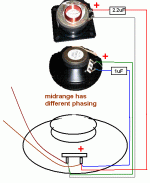Like this?
http://www.avx.hu/forum/uploads/monthly_08_2012/post-25988-040679200 1345636447.jpg
If the drivers are especially made for this speaker you can have the mid and bass cone having a natrual 12 dB low pass filter built into the frequeny response of the drivers. The closed box of the midrange gives a 12 dB high pass function. The crossover then is used to tweak some more.
The B&W 801 professional monitor as used in so many recording studios started with 24 dB octave filters that were quite complex. Over the years the filtering functions has been built into the drivers and far fewer components are used.
That being said, there are many speakers with crude crossovers where money is spent on bling rings and other useless things to make the boxes look "impressive"-
http://www.avx.hu/forum/uploads/monthly_08_2012/post-25988-040679200 1345636447.jpg
If the drivers are especially made for this speaker you can have the mid and bass cone having a natrual 12 dB low pass filter built into the frequeny response of the drivers. The closed box of the midrange gives a 12 dB high pass function. The crossover then is used to tweak some more.
The B&W 801 professional monitor as used in so many recording studios started with 24 dB octave filters that were quite complex. Over the years the filtering functions has been built into the drivers and far fewer components are used.
That being said, there are many speakers with crude crossovers where money is spent on bling rings and other useless things to make the boxes look "impressive"-
Yep, this is how they are exactly. One problem now, the drivers are in restoration and I will need some help to put them back togheder with the caps + and - wiring... I am replacing the internal wiring as well, because those wires seem too thin for what they have to cary for those drivers, and there is no fono absorbent material? I am putting some of that as well inside them! A basic thick layer inside, on the back of them!
Last edited:
It is clear from the picture above. Look at it carefully:
The woofer is crossoverless, connected with the thick cable.
The midrange is connected with 1uF. The green cable goes to negative (blue to 1uF).
The tweeter is 2nd order with 2.2uF and a coil. The grey cable goes to negative (White to 2.2uF).
To make sure which driver is inverted you can crosscheck from the position of the positive/negative poles and the picture above, but I believe the midrange is the one inverted (Green cable is midrange positive, goes to negative on the woofer).
There is no need to use extra thick cable as these are for tweeters. Unless you have spare.
Be careful when you use absorbent material. Do it with listening carefully. This is an old-technique design. The enclosure resonance might be used to enhance low level reverberation (like those thin wall enclosures in the old speakers).
The woofer is crossoverless, connected with the thick cable.
The midrange is connected with 1uF. The green cable goes to negative (blue to 1uF).
The tweeter is 2nd order with 2.2uF and a coil. The grey cable goes to negative (White to 2.2uF).
To make sure which driver is inverted you can crosscheck from the position of the positive/negative poles and the picture above, but I believe the midrange is the one inverted (Green cable is midrange positive, goes to negative on the woofer).
There is no need to use extra thick cable as these are for tweeters. Unless you have spare.
Be careful when you use absorbent material. Do it with listening carefully. This is an old-technique design. The enclosure resonance might be used to enhance low level reverberation (like those thin wall enclosures in the old speakers).
Ok, I did not say but I do now, I took all the wiring except the one for the speaker conector on the back and put aside for them new cables as the other ones seemed too flimsy for speakers! So how do I do? I connect 2 endings from one cap to another, solder + to + and - to - on tweeter mid and bass and then + from witch to + to what?
and put aside for them new cables as the other ones seemed too flimsy for speakers!
No, it doesn't look too flimsy. There is a good practice (ahem, among audiophiles) to use single core small wire for the tweeter. I have many cables, thick ones, expensive ones, unused, but I use similar size wire for my tweeters.
Here is I am attaching the wiring diagram. Please note:
1) It is a standard for drivers to have the POSITIVE pole on the right hand side if you face the drivers down (see the image).
2) I have no proof from looking at the picture that the POSITIVE of the woofer goes to positive of the amplifier, but it should be so, because with inverted absolute phase the bass will be less defined. (In multi-way speakers, the woofers are always connected non-inverted).
Attachments
- Status
- This old topic is closed. If you want to reopen this topic, contact a moderator using the "Report Post" button.
- Home
- Loudspeakers
- Multi-Way
- Jamo so poor crosover?
